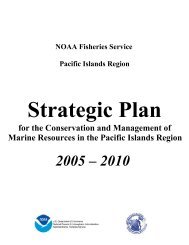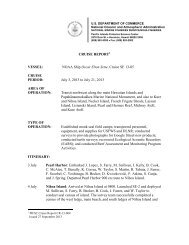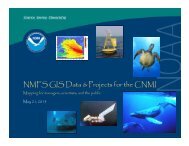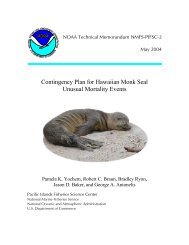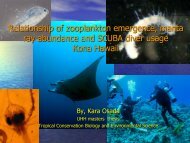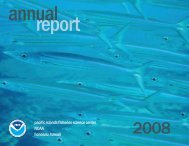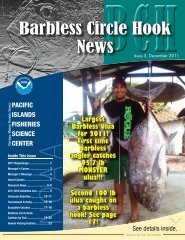Shark Predation on Hawaiian Monk Seals - Pacific Islands Fisheries ...
Shark Predation on Hawaiian Monk Seals - Pacific Islands Fisheries ...
Shark Predation on Hawaiian Monk Seals - Pacific Islands Fisheries ...
You also want an ePaper? Increase the reach of your titles
YUMPU automatically turns print PDFs into web optimized ePapers that Google loves.
Figure 3.--Number of pups born at FFS between 1984 and 2008.<br />
FFS was <strong>on</strong>ce the most populous site with more than 400 individuals residing there in the late<br />
1980s; however, the estimated number in 2006 was <strong>on</strong>ly 189 seals (NMFS, unpubl. data). The<br />
primary factors in the FFS subpopulati<strong>on</strong>’s decline have been poor juvenile survival<br />
exacerbated by lower reproductive rates. Survival of preweaned and recently weaned pups to<br />
age 1 at FFS was historically higher than in recent years, declining from about 95% in the late<br />
1980s to less than 75% in 7 of the last 8 years (Baker, 2008; Harting et al., in prep.). The<br />
prol<strong>on</strong>ged period of low juvenile survival at FFS has produced an anomalous age structure.<br />
Many of the reproductive females at FFS are now at an advanced age and are entering the<br />
phase of reduced fecundity, with few younger females to replenish the breeding populati<strong>on</strong>.<br />
C<strong>on</strong>sequently, the number of pups born at FFS has declined from approximately 120 in the late<br />
1980s to <strong>on</strong>ly 34 in 2009 (NMFS, unpubl. data). Populati<strong>on</strong> projecti<strong>on</strong>s using a dedicated<br />
stochastic simulati<strong>on</strong> model predict a steady decline at FFS over the next 25 to 50 years based<br />
<strong>on</strong> an assumpti<strong>on</strong> that current demographic rates and c<strong>on</strong>diti<strong>on</strong>s are representative of those that<br />
will occur over the lifetime period of the simulati<strong>on</strong> (Harting, 2002).<br />
Beginning in 1997, a marked increase in shark predati<strong>on</strong> <strong>on</strong> preweaned m<strong>on</strong>k seal pups at FFS<br />
occurred (Hawn, 2000; Hayes, 2002; NMFS, 2003; NMFS, 2004; NMFS, 2005) (Fig. 4). At<br />
Trig and Whaleskate <strong>Islands</strong>, the number of predati<strong>on</strong> mortalities from sharks (including both<br />
c<strong>on</strong>firmed and inferred losses, defined in Appendix C) peaked between 1997 and 1999.<br />
Additi<strong>on</strong>al pups were permanently maimed by severe shark bites that likely reduced the seals’<br />
ability to dive, forage and reproduce (Fig. 4).<br />
25




